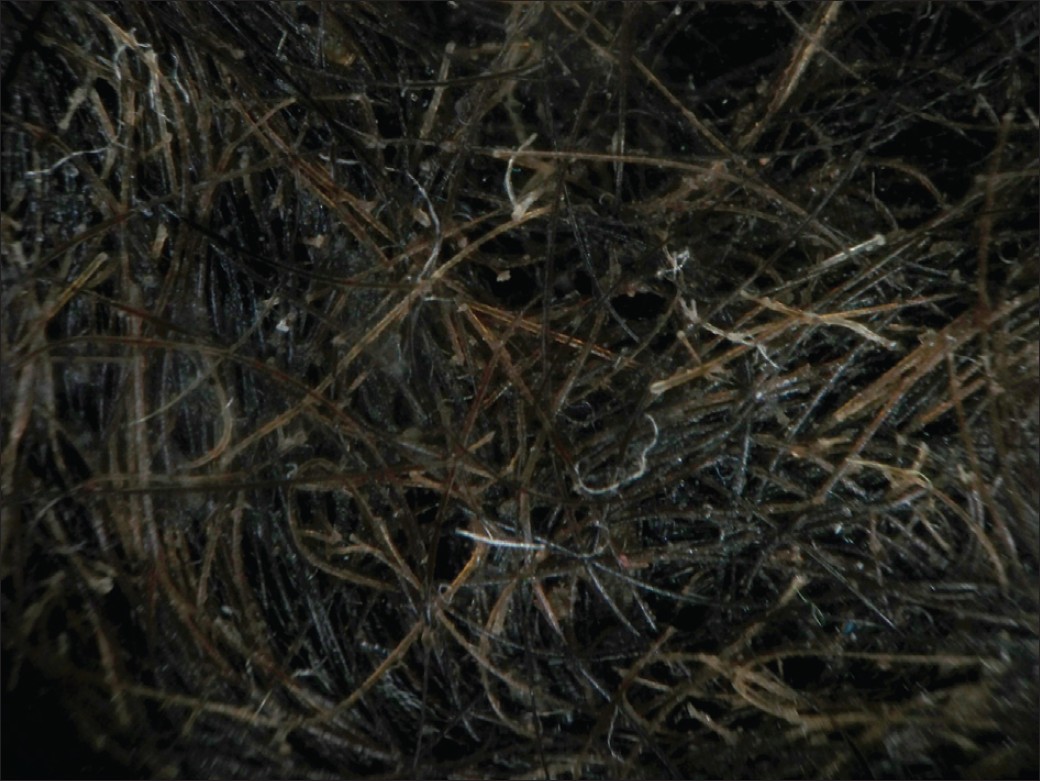Translate this page into:
Plica neuropathica (polonica): Clinical and dermoscopic features
Correspondence Address:
Devinder M Thappa
Professor and Head, Department of Dermatology and STD, JIPMER, Pondicherry-605 006
India
| How to cite this article: Ghodake NB, Singh N, Thappa DM. Plica neuropathica (polonica): Clinical and dermoscopic features. Indian J Dermatol Venereol Leprol 2013;79:269 |
Sir,
Plica neuropathica (polonica) presents as a compact mass of scalp hair with irregular twists and irreversibly entangled plaits which are firm to hard impenetrable mass of keratin cemented together with dirt and exudates. [1] It was prevalent in Poland in the 19th century, hence the name plica polonica or Polish plait. [2] Even though plica neuropathica is well described, its dermoscopic findings are not reported in the literature to the best of our knowledge, and hence it warranted reporting.
A 47 year old married religious lady who grazes cattle under the sun presented with matted scalp hair of 17 months duration. She had history of repeated episodes of matting of scalp hair for last 6 years. Each episode led to tonsuring and offering of her hair to God. Last tonsuring was done 22 months back. She used to oil and wash her scalp hair once a week with plain water with no intention to disentangle the hair once they got entangled, and once a month with gram flour and water. She had restrained herself from trying to disentangle or pull out matted scalp hair as she had developed fever and pus in the scalp skin, on trying to do so previously. She gave no history of use of shampoo or soap. Physical examination revealed single oval mass of dense matted hair over vertex and occipital scalp mimicking a "bird′s nest" [Figure - 1]a. Color of hair varied between black and golden brown; with golden brown hairs predominating over surface of matted hair mass [Figure - 1]b. Dermoscopic examination revealed intertwining of hair shafts with matting; and honey colored concretions mimicking "wrangled mesh of wires" appearance [Figure - 2]. There were no scalp erosions, nits or foul smelling discharge. On potassium hydroxide examination, no fungal hyphae were seen. The patient did not have any psychiatric disturbances.
 |
| Figure 1a: Mass of dense matted hair mimicking a "bird's nest"; (b) Golden brown hairs predominating over surface of matted hair mass |
 |
| Figure 2: Dermoscopic image with intertwining of hair shaft with matting; and honey colored concretions mimicking "wrangled mesh of wires" appearance |
The term "Plica neuropathica" was first used by Le Page in 1884 to describe a case of sudden onset entangled hair in a patient with hysteria. [3] He attributed the patient′s mental illness to have predisposed and perpetuated the matting of scalp hair. It is also called as felting and "bird′s nest" hair as seen in our case. Felting is a physical phenomenon well known in textile and wool industry, which causes conglomeration of contiguous fibers when exposed to friction and compression in a liquid medium. The exact etiopathogenesis of plica neuropathica (polonica) is not known. But it has been attributed to longitudinal splitting or weathering of hair shaft due to vigorous friction and frequent use of harsh shampoos and harsh cleansers; and/or due to keeping long hair with poor hair care or its neglect resulting in scalp hair infestations and scalp pyoderma. [4] It has also been reported following irritant contact dermatitis of the scalp. [5] Sometimes due to superstitious belief, it is encouraged by applying sticky materials over hair and not washing or combing. The common superstitious belief associated is that it helps in curing internal illnesses and cutting it would bring ill health. [2] In India, even though plica neuropathica is rare in general population, we see dreadlocks among Hindu religious persons (Sadhus). [6] Long hair when not combed or cut, entangles together leading to twisted masses of matted ropes of hair known as dreadlocks. Even in our case, hair once entangled was not combed with any intention to disentangle or cut, but instead of dreadlocks, a single compacted mass was formed similar to a hair bun worn by ladies. People with dreadlocks wash their hair regularly contrary to the popular belief, so was it in our case. Plica neuropathica has also been reported in two cases with pancytopenia following azathioprine use and it was attributed to cuticular damage of hair shaft in absence of poor hair care practices. [7],[8] Treatment of plica neuropathica involves cutting the matted hair. In early cases, manual separation using organic solvents can be tried. [4] Prevention includes hair care measures like regular cleaning of hair with mild cleansers or shampoos, gentle oiling and combing to avoid entangling and regular hair trimming. Hair piling over vertex while washing and backcombing should be avoided. [4] Our case had plica polonica probably due to poor hair care practices and thus we emphasize the importance of good hair care practices.
| 1. |
Kumar PN, Antony B, Chakravarthy A, Koyamu AM. Plica neuropathica (polonica) in schizophrenia-a case report and review of literature. Indian J Psychiatry 2001;43:281-3.
[Google Scholar]
|
| 2. |
Polish plait. Available from: http://en.wikipedia.org/wiki/Polish-plait. [Last accessed on 2012 Oct 14].
[Google Scholar]
|
| 3. |
Le Page JE. Neuropathica plica. Br Med J 1884;1:160.
[Google Scholar]
|
| 4. |
Marshall J, Parker C. Felted hair untangled. J Am Acad Dermatol 1989;20:688-90.
[Google Scholar]
|
| 5. |
Palwade PK, Malik AA. Plica neuropathica: Different etiologies in two cases. Indian J Dermatol Venereol Leprol 2008;74:655-6.
[Google Scholar]
|
| 6. |
Dreadlocks. Available from: http://en.wikipedia.org/wiki/dreadlocks. [Last accessed on 2012 Oct 14].
[Google Scholar]
|
| 7. |
Kwinter J, Weinstein M. Plica neuropathica: Novel presentation of a rare disease. Clin Exp Dermatol 2006;31:790-2.
[Google Scholar]
|
| 8. |
Joshi R, Singh S. Plica neuropathica (Plica polonica) following azathioprine-induced pancytopenia. Int J Trichol 2010;2:110-2.
[Google Scholar]
|
Fulltext Views
8,364
PDF downloads
1,067





